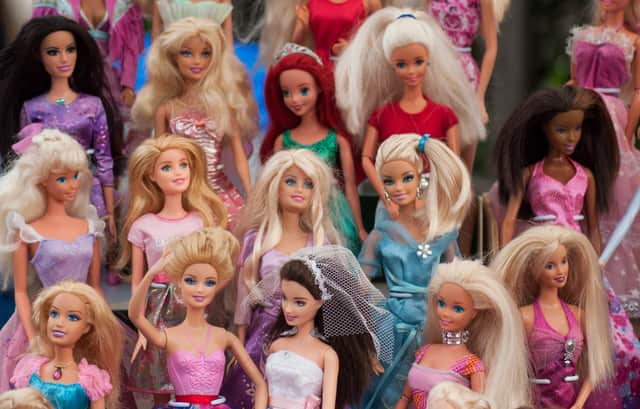Children don't think about Barbie's looks or her job, they just want to play - AI toys are a much bigger worry
and live on Freeview channel 276
This week all anyone can talk about is Barbie, thanks to the release of the long awaited Barbie film. It may have been over 60 years since the iconic doll first made her way onto toy shop shelves and into the hearts of children worldwide, but she’s still the subject of new merchandise on a regular basis.
The Barbie film, which stars Margot Robbie as a real life version of the famous doll and Ryan Gosling as her equally famous love interest Ken, is the first time Barbie has had an outing on the big screen but she has long been the focus of films, television shows, books and more. She’s also inspired everything from clothing to food and songs, and even paint colours.
Advertisement
Hide AdAdvertisement
Hide AdBarbie was first introduced in 1959 and in the years that have followed there have been countless versions of the doll created and sold. Some are inspired by a particular outfit or pastime and some simply have alternative hair colours, but they’re all unique in their own way. In fact, if you have some of the older Barbie dolls you may now find they are worth a lot of money, especially if they were limited edition.
Children play with Barbie dolls at home, at their friend’s houses, at play centres and even at schools. In any play box you will find at least one Barbie, but there will likely be many more. Mattel, the company which created Barbie, has also just given away free dolls to around 15,000 school children across the UK. But this move has been met with criticism from some experts who believe that Barbie reinforces gender stereotypes.
Now, this criticism is nothing new and it is one that has been levied at her for many years - I suspect almost as many as she has been around. I have to say, I completely disagree with this criticism. Yes, Barbie is skinny and tanned. Yes, she’s got long flowing blonde hair and perfect skin. And, yes, none of these things necessarily reflect a real woman’s body. But, since when do all toys completely reflect reality?
Rochelle BarrandI truly believe Mattel is doing the best they can in an almost impossible situation
I am a child of the 90s so as well as playing with my Barbie dolls I also played with baby dolls which had a voice box which had to be turned on with a switch on their back - and even then they only made two noises. That’s certainly not an accurate reflection of real babies. I loved my Furby too, but that’s not based on a real animal. And while we’re talking about toys which depict skinny blonde girls, does anyone remember Betty Spaghetty? She also had legs that went on forever and wore a rather short skirt. But did anyone mind about those things? I don’t remember that anyone did.
Advertisement
Hide AdAdvertisement
Hide Ad

As a child I never thought about things though. I was just excited to play with a doll and invent different scenarios for my Barbie and Ken. I didn’t give a thought to Barbie’s waist size or what she did for a job. I was too busy taking her off on magical adventures on her unicorn - another completely inaccurate representation of reality as unicorns do not exist. But, that’s fine as play is meant to be fun, imaginative and creative. It’s meant to be an escape.
I was a child, I was innocent, and that’s how children should be. I do worry that those who raise concerns about Barbie are projecting their worries, which are shaped by an adult’s perception of the world, onto children and introducing topics to them that they would have never even otherwise thought about. I know it’s been a long time since I was playing with Barbies myself and the world has changed greatly in many ways since the 90s but I do like to think that childhood innocence still exists.
It’s not that I don’t think that toy makers need to adapt and change to fit with modern society and changing attitudes, I do. But, I think Mattel has adapted. They have created Barbies with different body shapes, for example, and regularly create collections which reflect a range of different professions and are inspired by real life female pioneers. I think that’s a wonderful step forward. However, I do believe that Mattel is somewhat stuck between a rock and a hard place because with the best will in the world it will never be able to create a doll for every scenario that life could present so it can only ever do so much.
In addition, if it were to create a Barbie which was very obviously overweight, for example, there would be an outcry that it was trying to glamourise an unhealthy lifestyle. Equally, if it withdrew Barbies with the original skinny body shape from the market there would be a lot of upset as fans wouldn’t want to see the traditional doll disappear. I truly believe Mattel is doing the best it can in an almost impossible situation.
Advertisement
Hide AdAdvertisement
Hide AdPlus, one expert has predicted that as AI technology is incorporated with toys in future this could lead to “horrendous” consequences - such as toys being hacked or programmed to be able to sell things to children. If this prediction comes true then Barbie dolls are the last thing we have to worry about when it comes to the impact the toy industry will have on our children.
Comment Guidelines
National World encourages reader discussion on our stories. User feedback, insights and back-and-forth exchanges add a rich layer of context to reporting. Please review our Community Guidelines before commenting.
